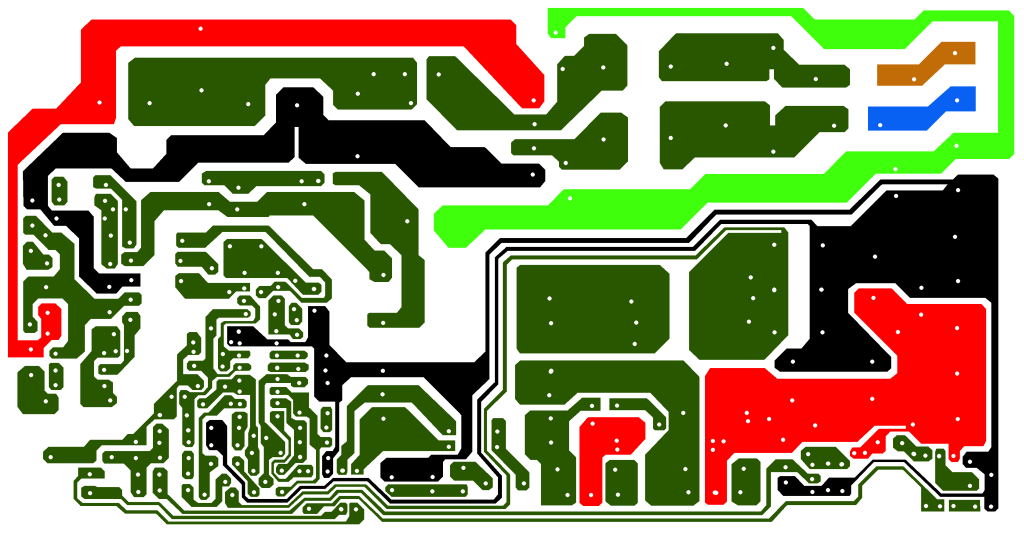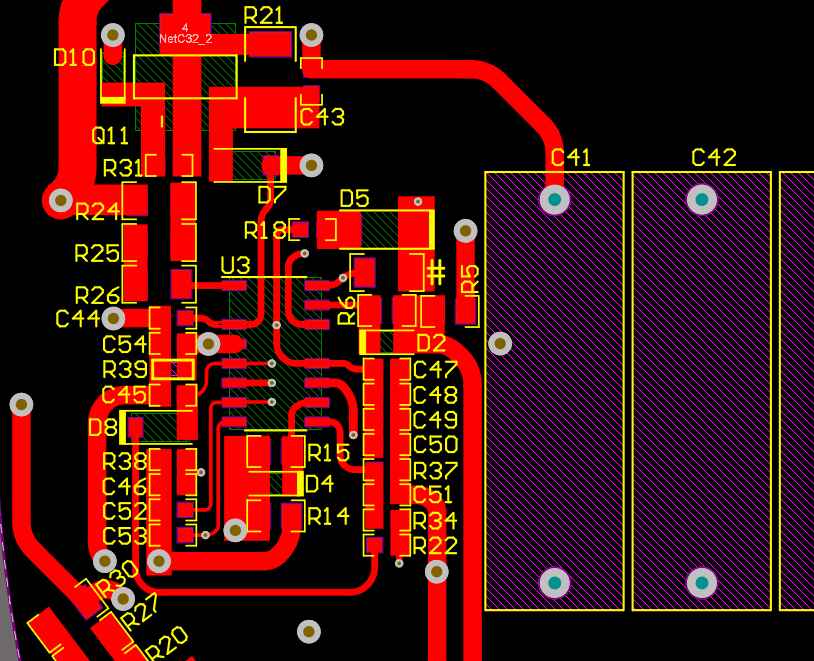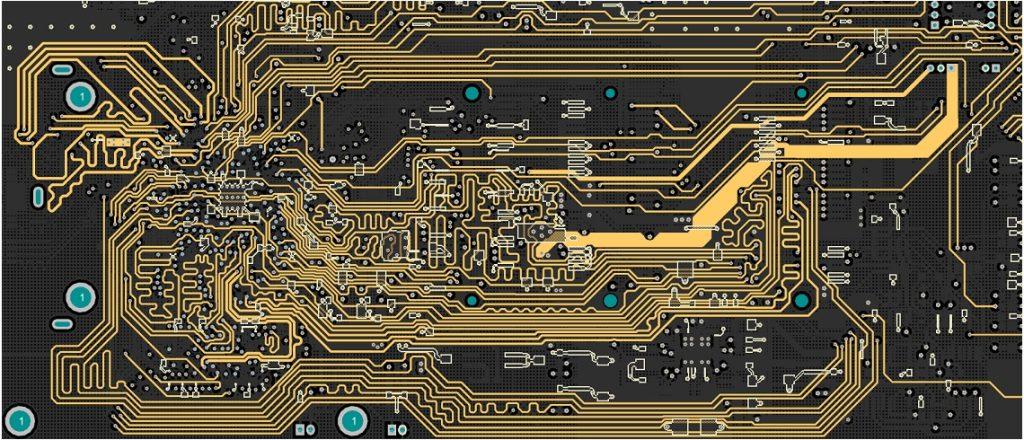In any switching power supply design, the physical design of the PCB board is the last link. If the design method is inappropriate, the PCB may radiate too much electromagnetic interference, causing the power supply to work unstable; the following analysis of the matters requires attention in each step.
- 1. from the schematic to the PCB design process
- 2. Parameter setting
- 3. Component layout
- 4. Wiring
- 5. Check
- 6. Design output
- Contact us
1. from the schematic to the PCB design process
Create component parameters -> input schematic netlist -> design parameter settings -> manual layout -> manual wiring -> verify the design -> review -> CAM output.
2. Parameter setting
The spacing between adjacent wires must meet the electrical safety requirements, and the spacing should be as wide as possible for ease of operation and production. The minimum spacing should at least be suitable for the voltage withstand; in the wiring density is low, the spacing of the signal lines can be increased appropriately, and the high and low-level disparity of the signal lines should be as short as possible and increase the spacing, in general, the alignment spacing is set to 8 mil. the edge of the hole in the solder pad to the edge of the printed board distance to be greater than 1mm, which can avoid the processing of the pads lead to defective. When the connection with the pad of the line is thin, the connection between the pad and the line is designed as a teardrop, the advantage is that the pad is not easy to skin, but the line and the pad are not easy to disconnect.

3. Component layout
The practice has proved that even if the circuit schematic design is correct, if the printed circuit board is not properly designed, it will hurt the reliability of electronic equipment. For example, suppose the printed board has two thin parallel lines. In that case, it will form a delay in the signal waveform, the formation of reflected noise at the end of the transmission line, and interference caused by poorly considered power and ground lines will degrade the product’s performance. Each switching power supply has four current circuits.
◆ Power switching AC circuit
◆ Output rectifier AC circuit
◆ Input signal source current loop
◆ Output load current loop input loop
An approximate DC charges the input capacitor, and the filter capacitor mainly serves as broadband energy storage; similarly, the output filter capacitor is used to store the high-frequency energy from the output rectifier and to eliminate the DC energy from the output load circuit. Therefore, the terminals of the input and output filter capacitors are very important. The input and output current circuits should be connected to the power supply only from the terminals of the filter capacitors, respectively; if the connection between the input/output circuit and the power switch/rectifier circuit cannot be directly connected to the terminals of the capacitors, the AC energy will be radiated to the environment by the input or output filter capacitors.
These two loops are most susceptible to electromagnetic interference, so these AC loops must be laid out before other printed line wiring in the power supply; the three main components of each loop are filter capacitors, power switches or rectifiers, inductors or transformers, which should be placed next to each other, adjusting the position of the components so that the current path between them is as short as possible.
The best way to establish a switching power supply layout is similar to its electrical design, with the best design flow being as follows.
1. Place the transformer
2. design the power supply switching current loop
3. design the output rectifier current loop
4. connect to the control circuit of the AC power supply circuit
Design the input current source circuit and input filter Design the output load circuit and output filter. According to the functional unit of the circuit, the layout of all circuit components should conform to the following principles.
● First, consider the size of the PCB. When the PCB size is too large, the printed lines are long, the impedance increases, the noise immunity decreases, and the cost increases; too small, the heat dissipation is not good, and the neighboring lines are susceptible to interference. The best shape of the circuit board is rectangular, with an aspect ratio of 3:2 or 4:3, located at the edge of the board components, from the edge of the board is generally not less than 2mm
● Consider the future welding when placing the devices, and do not be too dense
Each functional circuit’s core component should be the layout’s center. Components should be evenly, neatly, and compactly arranged on the PCB, minimize and shorten the leads and connections between each component, and decoupling capacitors should be as close as possible to the VCC of the device
The distribution parameters between components should be considered for circuits operating at high frequencies. The general circuit should be arranged in parallel as much as possible. This way, it is beautiful, easy to assemble, solder, and easy to mass produce.
● Arrange the location of each functional circuit unit according to the flow of the circuit so that the layout facilitates signal flow and keeps the signals in the same direction as much as possible
● The first principle of layout is to ensure the wiring rate of the cloth, pay attention to the connection of the flying wires when moving the devices, and put the devices that have a connection relationship together.
● Reduce the loop area as much as possible to suppress the radiation interference of the switching power supply.
4. Wiring
Switching power supply contains high-frequency signals, any printed lines on the PCB can play the role of the antenna; the length and width of the printed lines will affect its impedance and inductive resistance, thus affecting the frequency response. Even though the DC signal printed lines will be coupled from the adjacent printed lines to the RF signal and cause circuit problems (or even re-radiate the interference signal). Therefore, all the printed lines through the AC should be designed to be as short and wide as possible, which means that all the components connected to the printed lines and connected to other power lines must be placed very close.
The length of the printed line is proportional to the inductance and impedance it exhibits, while the width is inversely proportional to the inductance and impedance of the printed line. The length reflects the wavelength of the printed line response. The longer the length, the lower the frequency the printed line can send and receive electromagnetic waves and the more RF energy it can radiate. According to the printed circuit board’s current size, try to add rent power line width and reduce the loop resistance. At the same time, the power line, ground line direction, and current direction are the same, which helps to enhance the ability to resist noise. Grounding is the bottom branch of the four current circuits of the switching power supply; as the common reference point of the circuit plays a very important role, it is an important way to control interference. Therefore, the placement of grounding wires should be carefully considered in the layout. Mixing various grounding will cause the power supply to work unstably.
5. Check
After the wiring design is completed, it is necessary to carefully check whether the design conforms to the rules set by the designer and confirm whether the rules are set to meet the printed board production process requirements. Generally, check whether the distance between the line and line, line and component pad, line and through-hole, component pad and through-hole, through-hole and through-hole is reasonable and whether it meets the production requirements. Whether the width of the power and ground lines are appropriate, and whether there are still places in the PCB where the ground line can be widened. Note: Some errors can be ignored; for example, for some of the connector’s Outline part of the board outside the frame, check the spacing will be wrong; in addition, every time you modify the alignment and through-hole, you have to re-copper.
Review according to the “PCB checklist,” including design rules, layer definition, line width, spacing, pads, and vias settings, but also focus on reviewing the rationality of device layout, power, ground network alignment, high-speed clock network alignment, and shielding, decoupling capacitor placement and connection, etc.

6. Design output
Notes for outputting the optical drawing file.
● The layers to be output are the wiring layer (bottom layer), silkscreen layer (including top layer silkscreen, bottom layer silkscreen), solder resist layer (bottom layer solder resist), drilling layer (bottom layer), in addition to generating drilling file (NC Drill)
● When setting the layer of the screen printing layer, do not select the Part Type, and select the Outline, Text, Line of the top layer (bottom layer), and the screen printing layer.
● When setting the layer of each layer, select the Board Outline, and when setting the layer of the screen printing layer, do not select the Part Type, and select the top layer (bottom layer) and the Outline, Text, and Line of the screen printing layer.
When generating the drill file, use the default settings of PowerPCB and do not change anything.
Contact us
From the beginning of the project to the finish line, we will be in constant contact with you to keep you informed of the entire process, from manufacturing to assembly. This can help you save money and stress with lower PCB costs, shorter wait times, and higher-quality products. We want to save you time and effort so you can focus on your PCB design – without worrying about the nitty-gritty of the manufacturing process.



